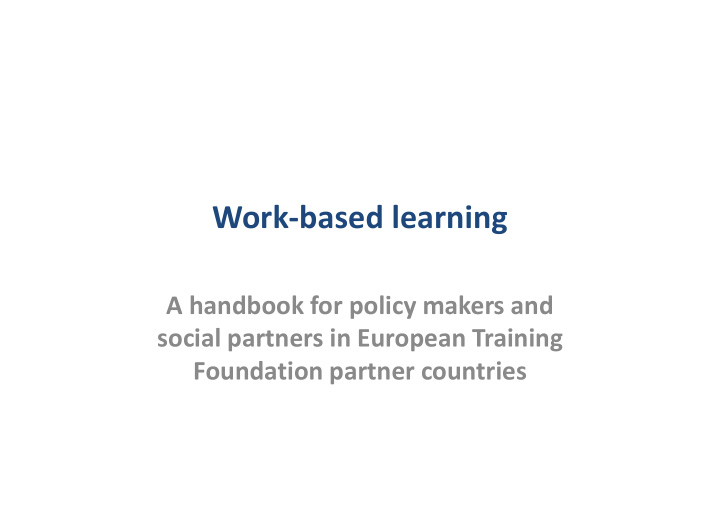



Work-based learning A handbook for policy makers and social partners in European Training Foundation partner countries
The task • Use plain English • Make it attractive to look at – Figures, illustrations, photos, tables Focus on middle- and low-income countries • Focus on work-based learning in vocational education and training • – But also other ways to use it • Design it for policy makers and social partners – Busy people need shorter rather than longer things to read • Show what is possible – Suggest options, not solutions – Not problems, barriers, constraints • Emphasise what is practical – Not academic, theoretical or bureaucratic
The structure 1. Introduction 2. Why work-based learning matters 3. Work-based learning and middle- and low-income countries 4. Making a choice between different types of work-based learning 5. Work-based learning and learning in the classroom 6. Starting and expanding work-based learning programmes 7. Ensuring the quality of work-based learning 8. Assessing and recognising work-based learning 9. Financing work-based learning 10. Governing work-based learning Annexes
Work-based learning: Everyone wins Employers Vocational education Employees and training Skills Productivity Motivation Jobs Public Schools Employment Service
Work-based learning in middle- and low- income countries Opportunities Challenges
Work-based learning: Which model? Apprenticeship Vocational qualifications and skills Alternance Work habits and ? Simulated employability workplaces Career choice Traineeships Unemployment and Learning about work disadvantage
Building sustainable work-based learning systems and programmes Shared Policy Legislation vision framework Financing Social partners Social partner Government ownership Political support Use international Avoid competing systems Take a long-term view partnerships of work-based learning Build basic tools: skill Build knowledge and standards, curriculum, Market and skills: enterprise trainers, skill lists, assessment communicate assessors, teachers tools
Advantages of informal apprenticeships o They are a socially accepted type of training that provides relevant skills and increases apprentices’ employment chances once they finish training. o The cost can be lower than formal vocational education and training. o Where connections between formal vocational education and training institutions and the workplace are weak, employers often say that informal apprenticeships develop higher quality skills than the formal system. o They can be an important source of innovation and productivity for micro and small enterprises. Disadvantages of informal apprenticeships o The skills that are developed can be specific to a particular enterprise, and so reduce apprentices’ later labour market mobility, as well as limiting the depth and range of skills available to the economy as a whole. o Hours can be long, wages low, and working conditions poor. o The social partners have very limited or no involvement. Policy challenges for informal apprenticeships o Do we upgrade informal apprenticeships, or try to introduce formal apprenticeships? Or try to do both at the same time? o How can we upgrade the quality of informal apprenticeships without reducing employers’ willingness to offer them? The section on quality later in this handbook discusses this.
Questions that are important today • Does it meet a need? Will it be useful? • What needs to be expressed more clearly? • Are there any mistakes? • Is there anything that needs to be removed? • What needs to be added? • What about the country examples: – Are they balanced? • Among ETF partner countries • Between ETF partners and EU/OECD countries – Should any be removed? – Do you know of any better examples that should be added? • Do you have any photos or illustrations that could be added?
1. Introduction • Purposes of the handbook • Outline of the content • What is work-based learning?
2. Why work-based learning matters • Benefits for stakeholders – Enterprises, – Learners, – Employees, – Public policy makers, – Schools and colleges, – Public Employment Services
3. Work-based learning in low- and middle-income countries • Examples of work-based learning programmes in low- and middle-income countries • Policy lessons from these examples • Some challenges in low- and middle-income countries • Questions for policy makers
4. Making a choice between different models of work-based learning • Policy issues • The main types of work-based learning programmes – The learner is an employee • Formal apprenticeship • Informal apprenticeship [?] – The learner is a student • Traineeships, internships, work placements, alternance [?] – Borderline cases - simulations • Virtual firms, training firms Learning about work – • Rather than how to do it • Advantages and disadvantages of each • Differences between and within each • Blurred distinctions
5. Work-based learning and learning in the classroom • Substitutes or complements? • Integrating and co-ordinating the two – What should be learned in the workplace? – What should be learned in the classroom? – How should each be organised?
6. Starting and expanding work-based learning programmes • National examples • Policy lessons from these examples
7. Ensuring the quality of work-based learning • A framework • Strengthening enterprise capacity • Practical tools for learners and enterprises • Formal mechanisms: legislation and regulation • Raising the quality of informal apprenticeships
8. Assessing and recognising work- based learning • Why assessment and recognition are policy issues • Questions with issues and options – Should work-based learning be assessed and recognised? – What is the purpose of assessment? – How often to assess? – Who should assess and certify work-based learning? – How should work-based learning be assessed • Some examples
9. Financing work-based learning • Introduction – What needs to be financed? – What level of resources will be needed? – Who should pay for what? • Seven factors that influence the level and distribution of costs – Questions about each and options for answering them • Policy issues in financing work-based learning programmes – Issues associated with seven cost elements • Examples of how financing issues have been addressed
10. Governing work-based learning • What is governance? • What is good governance? • Practical implications and examples
Recommend
More recommend